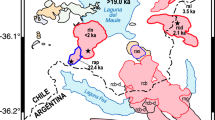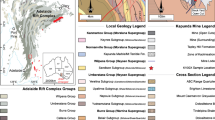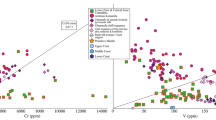Abstract
The present study reports the occurrence of orthopyroxene megacrysts from the Chilka Lake anorthosite massif, Eastern Ghats, India. An insight into the mineral chemistry of different phases, coupled with detailed field and petrographic evidences from this study, shed light on a long debate on the origin of orthopyroxene megacrysts in anorthosite massifs. The megacrysts contain exsolved lamellae of plagioclase and opaque oxides (ilmenite, rutile) oriented along orthopyroxene cleavage planes. The trace element distribution patterns of the megacryst and matrix plagioclase are mirror reflections of each other and mutually complementary. The calculated compositions of melts in equilibrium with these two phases show comparable patterns for LREE (light rare earth elements, La–Sm), but differ markedly in terms of HREE (heavy rare earth elements, Eu–Lu), suggesting that the megacrysts and matrix plagioclases did not crystallize simultaneously. We infer that the orthopyroxene megacrysts have a longer crystallization history, initially as a low-Ca non-quad member of the pyroxene group at pressure ≥ 10 kbar, incorporating some amount of Ca, Al and Ti in their structure. Subsequently, they have been carried by a plagioclase crystal mush to mid-crustal levels at pressure ~ 4–6 kbar following a near-isothermal decompression that may be linked to the emplacement of the anorthosite massif, giving rise to the exsolution lamellae of plagioclase and opaque oxides.








Similar content being viewed by others
References
Ashwal LD (1993) Anorthosites. Springer, Berlin, Heidelberg. https://doi.org/10.1007/978-3-642-77440-9
Bhattacharya S (1996) Eastern Ghats granulite terrain of India: an overview. J Southeast Asian Earth Sci 14:165–174
Bhattacharya S, Sen SK, Acharyya A (1994) The structural setting of the Chilka Lake granulite-migmatite-anorthosite suite with emphasis on the time relation of charnockites. Precambrian Res 66:393–409
Bybee GM, Ashwal LD, Shirey SB, Horan M, Mock T, Andersen TB (2014) Pyroxene megacrysts in Proterozoic anorthosites: Implications for tectonic setting, magma source and magmatic processes at the Moho. Earth Planet Sci Lett 389:74–85
Carmichael ISE, Nicholls J (1967) Iron–titanium oxides and oxygen fugacities in volcanic rocks. J Geophys Res 72:4665–4687
Chakrabarti R, Basu AR, Bandyopadhyay PK, Zou H (2011) Age and origin of the Chilka anorthosites, Eastern Ghats, India: Implications for massif anorthosite petrogenesis and break-up of Rodinia. In: Ray J, Sen G, Ghosh B (eds) Topics in igneous petrology. Springer, Dordrecht, pp 355–382
Charlier B, Duchesne JC, Auwera JV, Storme JY, Maquil R, Longhi J (2010) Polybaric fractional crystallization of high-alumina basalt parental magmas in the Egersund-Ogna massif-type anorthosite (Rogaland, SW Norway) constrained by plagioclase and high-alumina orthopyroxene megacrysts. J Petrol 51:2515–2546
Chatterjee N, Crowley JL, Mukherjee A, Das S (2008) Geochronology of the 983-Ma Chilka Lake anorthosite, Eastern Ghats Belt, India: Implications for pre-Gondwana tectonics. J Geol 116:105–118
Dasgupta S, Bose S, Das K (2013) Tectonic evolution of the Eastern Ghats Belt, India. Precambrian Res 227:247–258
Dobmeier CJ, Raith MM (2003) Crustal architecture and evolution of the Eastern Ghats Belt and adjacent regions of India. Geol Soc Spec Publ 206:145–168
Dymek RF, Gromet LP (1984) Nature and origin of orthopyroxene megacrysts from the St-Urbain anorthosite massif, Quebec. Can Mineral 22:297–326
Emslie RF (1975) Pyroxene megacrysts from anorthositic rocks: new clues to the sources and evolution of the parent magmas. Can Mineral 13:138–145
Emslie RF, Hamilton MA, Thériault RJ (1994) Petrogenesis of a Mid-Proterozoic anorthosite-mangerite-charnockite-granite (AMCG) complex: Isotopic and chemical evidence from the Nain Plutonic suite. J Geol 102:539–558
Emslie RF, Hunt PA (1990) Ages and petrogenetic significance of igneous mangerite-charnockite suites associated with massif anorthosites, Grenville Province. J Geol 98:213–231
Gasparik T, Lindsley DH (1980) Phase equilibria at high pressure of pyroxenes containing monovalent and trivalent ions. In: Prewitt CT (ed) Pyroxenes. Rev Mineral, vol 7. Miner Soc Am, Washington DC, pp 309–340
Ghiorso MS, Evans BW (2008) Thermodynamics of rhombohedral oxide solid solutions and a revision of the Fe-Ti two-oxide geothermometer and oxygen-barometer. Am J Sci 308:957–1039
Krause O, Dobmeier C, Raith MM, Mezger K (2001) Age of emplacement of massif-type anorthosites in the Eastern Ghats Belt, India: constraints from U-Pb zircon dating and structural studies. Precambrian Res 109:25–38
Leelanandam C (1990) The anorthosite complexes and Proterozoic mobile belt of peninsular India: A review. Dev in Precam Geol 8:409–435
Longerich HP, Jackson SE, Günther D (1996) Laser ablation inductively coupled plasma mass spectrometric transient signal data acquisition and analyte concentration calculation. J Anal at Spectrom 11:899–904
Mitchell JN, Scoates JS, Frost CD (1995) High-Al gabbros in the Laramie anorthosite complex, Wyoming: implications for the composition of melts parental to Proterozoic anorthosite. Contrib Mineral Petrol 119:166–180
Morishita T, Ishida Y, Arai S, Shirasaka M (2005) Determination of multiple trace element compositions in thin (< 30 μm) layers of NIST SRM 614 and 616 using laser ablation-inductively coupled plasma-mass spectrometry (LA-ICP-MS). Geostand Geoanal Res 29:107–122
Morse SA (1975) Plagioclase lamellae in hypersthene, Tikkoatokhakh Bay, Labrador. Earth Planet Sci Lett 26:331–336
Mukherjee A, Jana P, Das S (1999) The Banpur-Balugaon and Bolangir anorthosite diapirs of the Eastern Ghats, India: Implications for the massif anorthosite problem. Int Geol Rev 41:206–242
Mukhopadhyay D, Basak K (2009) The Eastern Ghats belt- A polycyclic granulite terrain. J Geol Soc India 73:489–518
Owens BE, Dymek RF (1995) Significance of pyroxene megacrysts for massif anorthosite petrogenesis: Constraints from the Labrieville, Quebec, pluton. Am Mineral 80:144–161
Pearce NJG, Perkins WT, Westgate JA, Gorton MP, Jackson SE, Neal CR, Chenery SP (1997) A compilation of new and published major and trace element data for NIST SRM 610 and NIST SRM 612 glass reference materials. Geostand Geoanalytical Res 21:115–144
Zhao D, Essene EJ, Zhang Y (1999) An oxygen barometer for rutile–ilmenite assemblages: oxidation state of metasomatic agents in the mantle. Earth Planet Sci Lett 166:127–137
Pouchou JL, Pichoir F (1991) Quantitative analysis of homogeneous or stratified microvolumes applying the model “PAP”. In: Heinrich KFJ, Newbury DE (eds) Electron Probe Quantitation. Springer, Boston, MA, pp 31-75. https://doi.org/10.1007/978-1-4899-2617-3_4
Putirka KD (2008) Thermometers and barometers for volcanic systems. In: Putirka KD, Tepley FJ III (eds) Minerals, inclusions and volcanic processes. Rev Mineral Geochem, vol 69. Miner Soc Am, Chantilly, pp 61–120
Ramakrishnan M, Nanda JK, Augustine PF (1998) Geological evolution of the Proterozoic Eastern Ghats mobile belt. Geol Surv India Spl Pub 44:1–21
Rickers K, Mezger K, Raith MM (2001) Evolution of the continental crust in the Proterozoic Eastern Ghats belt, India and new constraints for Rodinia reconstruction: implications from Sm–Nd, Rb–Sr and Pb–Pb isotopes. Precambrian Res 112:183–210
Sarkar A, Bhanumathi L, Balasubrahmanyan MN (1981) Petrology, geochemistry and geochronology of the Chilka Lake igneous complex, Orissa state, India. Lithos 14:93–111
Schnetzler CC, Philpotts JA (1970) Partition coefficients of rare-earth elements between igneous matrix material and rock-forming mineral phenocrysts–II. Geochim Cosmochim Acta 34:331–340
Sen SK, Bhattacharya S, Acharyya A (1995) A multi-stage pressure−temperature record in the Chilka Lake granulites: the epitome of the metamorphic evolution of Eastern Ghats, India? J Metamorphic Geol 13:287–298
Sun SS, McDonough WF (1989) Chemical and isotopic systematics of oceanic basalts: implications for mantle composition and processes. Geol Soc Spec Publ 42:313–345
Vander Auwera J, Longhi J (1994) Experimental study of a jotunite (hypersthene monzodiorite): constraints on the parent magma composition and crystallization conditions (P, T, \(f_{O_2}\)) of the Bjerkreim-Sokndal layered intrusion (Norway). Contrib Mineral Petrol 118:60–78
Acknowledgements
We wish to express our sincere gratitude to Akihiro Tamura and Juan Miguel Guotana for their kind assistance in acquiring and processing the LA-ICP-MS data and X-ray elemental maps. Analytical facilities were provided by the Central Petrological Laboratory, Geological Survey of India, Kolkata, and the Earth Science Department, Kanazawa University. We thank one anonymous reviewer, and journal editors Anton R. Chakhmouradian and Lutz Nasdala, for their insightful comments that improved the quality of the manuscript. Financial support from the University Grants Commission (UGC), New Delhi, India, under UGC UPE-II project, sanctioned to the Department of Geology, University of Calcutta, for conducting EPMA analysis, is thankfully acknowledged.
Author information
Authors and Affiliations
Corresponding author
Additional information
Editorial handling: A. R. Chakhmouradian
Publisher's Note
Springer Nature remains neutral with regard to jurisdictional claims in published maps and institutional affiliations.
Supplementary Information
Below is the link to the electronic supplementary material.
Rights and permissions
About this article
Cite this article
Choudhuri, S., Kar, R., Bhattacharya, S. et al. Orthopyroxene megacrysts from the Chilka Lake anorthosite massif, Eastern Ghats, India: a clue to magmatic evolution. Miner Petrol 116, 273–286 (2022). https://doi.org/10.1007/s00710-022-00779-x
Received:
Accepted:
Published:
Issue Date:
DOI: https://doi.org/10.1007/s00710-022-00779-x




